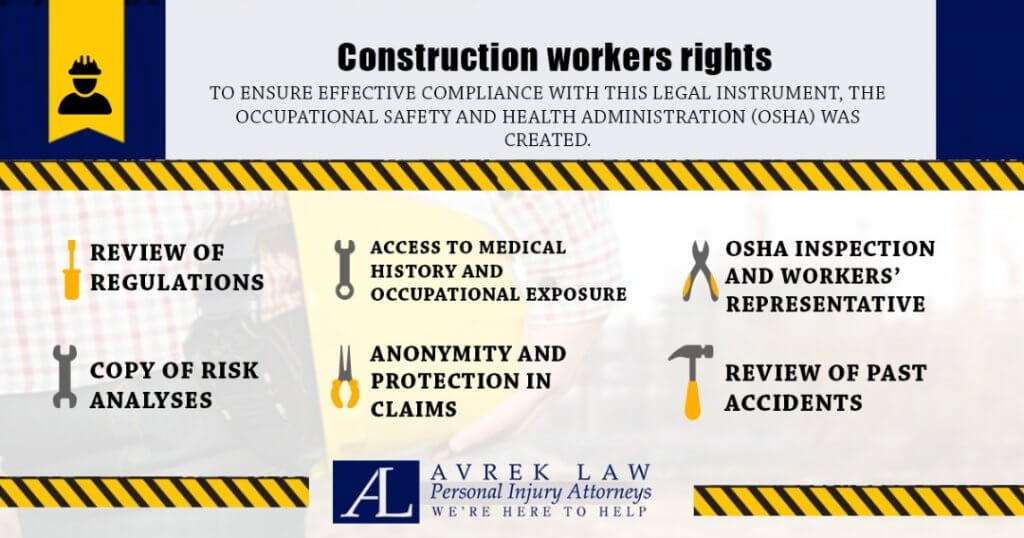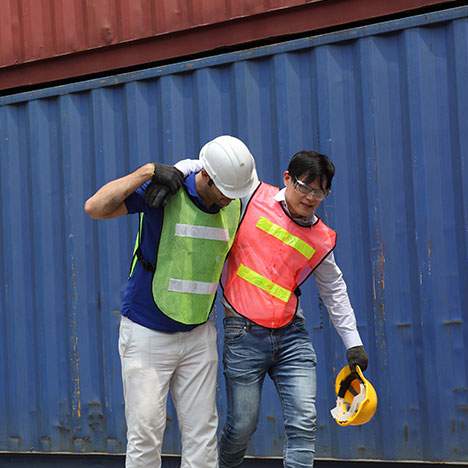The main reason for the creation of the Occupational Safety and Health Act in 1970 was to reduce the number of hazards and risks associated with workplaces in the construction sector. This law was the promoter of security strategies and mechanisms that greatly benefited construction workers rights.
However, in order to ensure effective compliance with this legal instrument, the Occupational Safety and Health Administration (OSHA) was created. Since then, all construction projects must be governed by these regulations to ensure the rights of construction workers. But, not all construction workers are aware of their rights, and this opens the door for companies to ignore the obligations of the Occupational Safety and Health Act in order to reduce costs. That is why it is necessary that all workers belonging to this sector are fully informed about labor laws for construction workers and the benefits that regulation grants them.
Construction Workers Rights
To ensure effective compliance with this legal instrument, the Occupational Safety and Health Administration (OSHA) was created.

Review of Regulations
According to current regulations, project managers in the construction sector must ensure that workers are informed about the standards, laws, regulations and norms that apply to the workplace. To do this, managers should place copies of all such material in the work area. In this way, construction worker rights are obvious, workers know their rights and make sure that the employer is effectively fulfilling them.
Access to Medical History and Occupational Exposure
Similarly, another right of a construction worker is access to any relevant medical records. In addition, OSHA requires the worker to have information on “occupational exposure,” i. e. radiation levels, toxicity, etc., available to him or her. Not infrequently, a construction company or firm has omitted this information from its workers.
OSHA Inspection and Workers Representative
Workers alone cannot stand up to a company if it is committing a labor law violation. Therefore, one of the construction is the demand for a review by OSHA. In addition, a beneficial aspect of this right is that workers can request this inspection for the slightest suspicion of non-compliance in the workplace.
On the other hand, workers may request a representative to defend their interests, who may be present during any OSHA inspection. It is a mechanism whose ultimate aim is to safeguard the rights of all construction workers.
Copy of Risk Analyses
Risk analysis, as its name indicates, is all those reviews, audits, inspections, etc. that are made with the purpose of locating the dangers and risks that may exist in a construction project. Companies must do so for law enforcement. But, the law also dictates that workers must have a copy of these analyses. Having it, construction workers become familiar with their workplace.
Anonymity and Protection in Claims
Workers can also rely on anonymity in the case of a complaint. In other words, the law allows construction workers to file complaints against their employer without disclosing their names. In addition to protecting the physical integrity of each worker, the right to anonymity motivates other workers to file claims with the certainty that the employer will not retaliate.
In conjunction with the right to anonymity, labor law itself provides protection for any worker who wishes to bring a complaint against his or her employer. The usefulness of this right can be seen in cases where the worker must or decides to disclose his name in a complaint.
In summary, a construction worker has two options: to file a claim anonymously or to file a claim with his or her first and last name without fear that the company will decide to retaliate with measures that directly affect the worker.
Review of Past Accidents
Construction workers also have the right to access and review documentation of accidents, illnesses and injuries that have occurred in the workplace.
Duties of Employers
Labor regulations not only stipulate rights of construction workers, but also establish a series of duties for employers. That is why every worker, in addition to ensuring that his or her rights are guaranteed, must make sure that his or her employer actually complies with the duties set forth in the labor regulations.

Safe Workplace
The first duty or obligation of any employer is the provision of a workplace where there is no danger or risk to the worker.
Safe Equipment and Tools
The obligation for an employer to provide a safe workplace is well known. However, few people are aware of another of an employer’s obligations: to supply equipment and tools whose use does not pose a risk to the worker. Therefore, the company or company must ensure that its workers are not using equipment that could endanger their physical integrity.
Inform OSHA Workers About Standards
If an OSHA worker performs a workplace inspection in the construction area, the site manager must inform him of the applicable standards and regulations.
OSHA Poster
Every building site must have an official OSHA sign that is widely visible. This official poster contains both workers’ rights and employers’ duties, so the latter must place it in an area characterized by visibility.
Risk Prevention Mechanisms
OSHA states that construction employers must put in place mechanisms that are useful to minimize the risks, ergo, the potential for accidents, injuries or illnesses. Mainly, employers must take three steps in that direction: (i) place informational labels on each of the materials used; (ii) issue documents regarding the degree of safety of these materials; and (iii) conduct courses to train and educate workers.
Understandable Courses
OSHA has emphasized one thing: the intelligibility of courses and/or training programs. Basically, it makes no sense for employers to run these programs without the workers understanding what they are being taught. That is why, together with the implementation of these programs, employers must ensure that these courses are truly understandable to their target audience.
Medical History and Occupational Exposure
The availability of medical records is both a right of the construction worker and an employer’s duty. This duality says a lot about the importance of every worker having access to medical records and documents that have information about the degree of toxicity in their workplace, that is, everything they are exposed to while working.
OSHA Inspections
The process preceding an OSHA inspection can be summarized in the following number of steps:
- If a worker or group of workers suspects that the employer is disregarding labor regulations, or suspects that there is a risk in the workplace that is not being mitigated, the worker or group notifies OSHA in writing.
- Once OSHA has been notified, it evaluates the request and, if it decides that there are sufficient elements, prepares a workplace inspection.
- It is essential that the OSHA inspector be accompanied by a representative who defends construction workers. This representative may be chosen by the union of workers or an internal process. The important thing is that (i) there is a representative and (ii) this representative is not chosen by the employer.
- The OSHA inspector can delimit his/her object of study: that is, he/she may conduct a review of the entire workplace or, conversely, he/she may inspect only one section (s).
- When the inspection is completed and the OSHA employee has made his or her report, he or she will contact the employer and meet him to discuss the issue, the current situation, and the measures that may or should be implemented.
The representative chosen by the workers can and must be present at this meeting. That is why it is essential that this representative exists, because agreements that are not beneficial to construction workers can be reached at that meeting
Work with an Experienced Construction Rights Attorney
If have been injured in a workplace accident and want to pursue a workplace injury claim, the attorneys at Avrek are more than happy to discuss your legal options. After a free consultation is free, you’ll receive expert advice from a law firm with $1 billion recovered in over 45,000 cases. As a “no win, no fee” law firm, you only pay our fee if we successfully resolve your case. Contact us today – we’re here to help!
